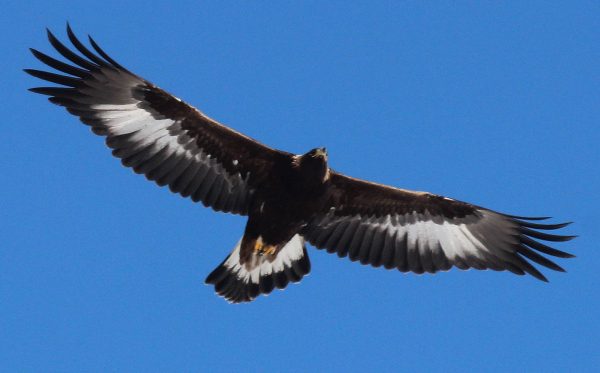
Golden Eagles have been most commonly sighted at the Mount Lorette, Alberta count site. This is a first-year Golden Eagle, which is indicated by the white coloration of some wing and tail feathers (photos by Paul Konrad).

Red-tailed Hawks are beginning to migrate north, with growing numbers being seen last week. To learn more about research being conducted on Red-tailed Hawks, you can refer to the presentation described at the end of this article.
|
Spring migration of birds of prey is exciting, fascinating, and quite different from fall raptor migration. Fewer raptor count sites are active during spring, primarily because raptor movements are less concentrated in space and time than fall migrations, but they are very interesting nonetheless. By March 1st, good numbers of Bald Eagles and Rough-legged Hawks were passing by count sites, even in the most northern parts of the continental United States and southern Canada. Now numbers of Red-tailed and Red-shouldered Hawks are bolstering numbers in some locations, along with Golden Eagles and vultures at other sites.
There will be ebbs and flows of different species as hawks and kites that wintered in Latin America, including Broad-winged Hawks that winter in the Amazon River basin, and Swainson’s Hawks that winter primarily in northern Argentina. Mississippi Kites and Swallow-tailed Kites will also provide streams of migration north in time, and you can monitor numbers observed daily, or as often as you wish to check on the migration progress of eagles, falcons, hawks, kites, and more at HawkCount – operated by the Hawk Migration Association of North America.
Some favorite HawkCount locations we’ve been monitoring include Mount Lorette, Alberta, where 401 Golden Eagles were counted last Friday. The Pembina Valley in Manitoba has been an interesting spring migration site for Bald Eagles and Rough-legged Hawks, with even more of these species passing through the Duluth, Minnesota area at the West Skyline Hawk Count, where the first Red-tailed Hawks are showing now with a filtering of Golden Eagles. Derby Hill Bird Observatory and nearby Braddock Bay in New York are seeing numbers of Red-shouldered Hawks, Red-tailed Hawks, and Turkey Vultures to start the early count season.
As is the norm, Swainson’s Hawks begin migrating into southern California much earlier than other parts of the nation, and numbers continued to increase at Borrego Valley over the weekend and into Monday. Bentsen-Rio Grande State Park in Texas experienced a first spring push of Broad-winged Hawks into the United States last Saturday, along with thousands of Turkey Vultures, while Fort Smallwood, Maryland and some New York hawkwatches also experiencing big Turkey Vulture flights with a variety of hawks being documented.
Most telling for what is yet to come are the counts being recorded at Tolima, Columbia, where thousands of Broad-winged Hawks and hundreds of Swainson’s Hawks are now migrating north. Watch for raptor count sites in Panama, Costa Rica, and Veracruz, Mexico to begin counting soon to document the spectacular migration of raptors north this spring too.
When referring to any of the spring raptor count sites, click on the name of the site to see the daily species count, but be sure to click on the word “Monthly” in the left margin of that page to see all daily totals of raptors counted during March, which will provide more interesting insights. Species numbers and composition will change as spring migration progresses, and it’s an enjoyable part of monitoring spring migration beyond your neighborhood to see regional and North American migration trends among birds of prey.
Reminder: If you are interested in learning more about raptors, especially a commonly encountered species, tomorrow there will be a presentation delivered entitled “The Red-tailed Hawk Project – developing a model system for studies in raptor ecology and evolution,” by Bryce Robinson from the Cornell Lab of Ornithology on Thursday March 21 at 12:00 noon EDT. It's part of the Birds of the World “Discovery Series” and you can Register for Free in advance to watch the webinar in real time or to receive video by email at Webinar Registration - Zoom